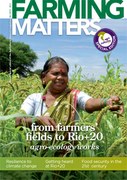Small‑scale farmers depend on biodiversity for their livelihoods and survival, yet agriculture can also be the greatest destroyer of biodiversity. Hivos and Oxfam Novib have recently launched a programme that aims to generate insights and evidence about the role of biodiversity in agriculture, and how to change to agricultural systems that harness biodiversity. This programme will last for three years and includes action research, network development and the establishment of a platform for public debates.

Agricultural biodiversity is about many things: about the genes of the wide variety of plants and animals; about individuals and the systems of which they are part, about policies and practices. What does agrobiodiversity mean in practice? And how can the wide knowledge and experience that exists contribute to better policies and practices?
Farmers, policy makers, financial institutions and businessmen need to know what the opportunities and possibilities are when talking about biodiversity in agriculture. We need to know how to enhance agricultural biodiversity and the existing (and potential) incentives and disincentives for doing so.
Many organisations, governments and businesses have been dealing with this complex set of issues for some time, and have developed specific approaches to it. “Agricultural diversity includes the components of biological diversity that are essential for nourishing human populations and improving their quality of life,” says Zachary Makanya of PELUM-Kenya. “Such diversity is the result of thousands of years of farmers’ and breeders’ activities, land and forest utilisation, combined with millions of years of natural selection. It is essential for our existence.”
Understanding agricultural biodiversity
“Food security means that good quality seeds at affordable prices are made accessible to farmers at the time that they need them. The approach should be to build and strengthen seed supply sources locally as much as possible.” A.V. Balasubramanian, Centre for Indigenous Knowledge Systems (CIKS), India.
“It is urgent to strengthen the indigenous systems for managing resources, and for the conservation of agricultural biodiversity, and that local farmers and farmers groups are encouraged to continue to conserve their time-tested local and indigenous seeds. Stop the introduction of GMOs since they destroy the local seeds systems and make farmers depend on corporations for their seeds.”
Zachary Makanya, Country Coordinator PELUM‑Kenya and Chairperson of the board of the Africa Biodiversity Network (ABN).
“Sustainable development can only be achieved by conserving and developing agricultural biodiversity, and through it enhancing food security, livelihoods and resilience in the face of climate change. Appropriate policies need to be put in place so that they lead to and support practical actions.”
Tenaw Hailu Tedela, Executive Programme Officer for the Sustainable Land Use Forum (SLUF)
The organisations involved in the Agrobiodiversity@knowledged programme focus on different aspects of the concept of agricultural biodiversity. The Sustainable Land use Forum (SLUF) in Ethiopia, for example, has been advocating for an integrated approach to agriculture and land use for years.
Tenaw Hailu Tedela says that agrobiodiversity gives us different benefits. “It provides the basis for the production of food. And an area’s biodiversity also means organisms that contribute to many diverse ecosystem services, from pest and disease regulation to carbon sequestration. Time and again, farmers show that it is the basis for food security and a sustainable livelihood. This is our most important incentive to preserve it.”
In India, the Centre for Indigenous Knowledge Systems (CIKS) aims to ensure that traditional knowledge on different species is used in contemporary agricultural systems.
“Agrobiodiversity is very important: just think of the number of varieties that are resistant to droughts, pests, and diseases,” says A.V. Balasubramanian. “Agrobiodiversity has helped us produce food in a way that is adapted to our local requirements, traditions and conditions. This does not only mean resistance to drought or pests – it also means higher yields.”
Current initiatives
CIKS started a community seed bank project in Tamil Nadu. Lost biodiversity has been brought back at the community level, as more than 130 varieties of paddy and 50 vegetable varieties are being sown in farmers’ fields and experimental farms. “Agrobiodiversity has to be locally conserved, and not only in cold storage rooms run by researchers”, explains A.V. Balasubramanian. “By creating awareness in the communities about the diversity and importance of traditional seed varieties, communities can continue benefitting from them, and ensure that the future generations will do so too”.
PELUM-Kenya and other like-minded organisations are currently rolling out the Ecological Organic Agriculture (EOA) Initiative. “PELUM-Kenya is coordinating this pilot initiative to promote ecological agriculture, and we will show that this is the kind of agriculture that will help solve Africa’s perennial hunger and poverty,” Zachary Makanya states. The aim is to mainstream organic agriculture into the national agricultural production systems by 2020 – by scaling-up best practices, increasing the visibility of ecologically grown food and through multiinstitutional partnerships.
The next steps
All these organisations agree that we need to pay more attention to agrobiodiversity. “We need not only to acknowledge its importance, but also increase our understanding of how to transform agriculture or, in other words, scale up successful programmes” says Gine Zwart of Oxfam Novib. The idea of a “green” economy is now high on the agenda, but many questions remain. What does “green” really mean? Who will govern this green economy? Do we need more knowledge to shape new policies and practices? Many high level policy makers may feel that this knowledge is hidden. However, it is right there in front of us if only we take the time to look and listen carefully to those who work with nature on a daily basis: farmers, fisherfolk and livestock keepers.
For more information please write to Gine Zwart (e-mail: gine.zwart@oxfamnovib.nl), Willy Douma (w.douma@hivos.nl) or to the participating organisations themselves: A. V. Balasubramanian at CIKS (info@ciks.org), Zachary Makanya at PELUM (makanya@pelum.net) or to Tenaw Hailu Tedela at SLUF (tenaw.hailu@gmail.com).

